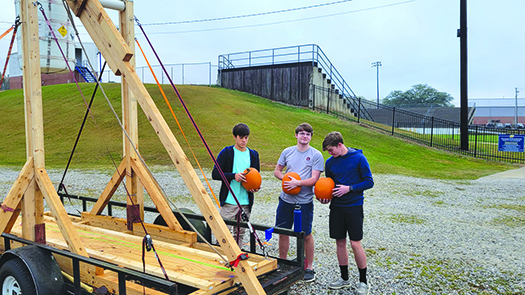BY KENDYL HOLLINGSWORTH
KENDYLH@OPELIKAOBSERVER.COM
BEAUREGARD —
Students in Rachel Brown’s AP Physics class at Beauregard High School just had an unconventional lesson in the laws of physics.
For the first time since 2019, students voted on a project in September to build catapults and trebuchets to see how far they could launch a pumpkin. After more than a month of preparation, they spent Halloween morning putting those catapults and trebuchets to the test in a “Pumpkin Chunkin’” contest to see which one could launch a pumpkin the farthest.
“In the past we have built and programmed battle bots, flown drones — but catapults and trebuchets seem to be the most popular,” Brown said.
In what she called a “student-centered project,” the students divided into teams of at least two and began researching their chosen launcher. They developed a list of supplies and began work from there, drawing up blueprints and recording their progress with pictures and videos.
Brown said she set a series of deadlines to keep the students on track and helped them work through any issues that arose.
“I will give them suggestions or help them develop an idea, but the class brainstorms, discusses and they lead the conversation,” she added. “… We discussed issues they were working on, and they would tell me how they were troubleshooting those problems.”
Catapults rely on the release of stored energy to launch a projectile from an arm across a great distance. Things like springs and elastics can be used to build up that tension before it’s released, similar to a slingshot. Once released, the arm rises in an arc motion to fling the projectile.
A trebuchet, on the other hand, relies on gravity to launch an object. According to PBS, it uses a lever that pivots on an axle. A counterweight is put at the short end of the lever, while the projectile often hangs in a sling attached to the other end. When the counterweight is dropped, the other end of the lever rises rapidly as the arm swings in an arc to launch the projectile.
According to Brown, the 2019 Pumpkin Chunkin’ contest saw a record-setting pumpkin launch of 204 feet. This year, however, there were six entries in the contest and two beat that record. The second-place team overtook the previous record by more than 20 feet, launching their pumpkin 225 feet.
The winning team — consisting of students Carter Dees, Alex Martin and Kyle Seeley — used a trebuchet to launch their pumpkin even further, measuring in at 235 feet. Brown said the team used a drum as their counterweight, but they filled it with water to give it extra weight.
The students’ parents were welcome to attend the Pumpkin Chunkin’ event, and Brown said she enjoyed seeing the joy from both sides.
“My favorite part was seeing our parents interact with their children,” she said. “We have wonderful, supportive parents that are invested in their children’s education, and seeing them all come together to encourage and help their children was a wonderful thing to witness. The students smiling, high fiving their dads and hugging their moms was nice to see. You can tell they were all invested in this project, which meant a lot to me, and knowing they had fun working on it.”
Besides the laws of physics and mechanics of these types of launchers, Brown said there were several other lessons to be learned from this project. One thing she said she hopes her students learned is that trial and error is a good thing.
“Learning from failure can be the best way to learn because they have to set back and figure out what went wrong, and how can they make it better,” Brown explained. “When a problem comes up, don’t give up, just continue to work the problem. I am proud to say that I believe my students did just that.”
While some groups faced more challenges than others, Brown said they were all successful in the end.
“They never gave up, and I think it will be an experience that they will remember for years to come,” she said. “It’s great to combine learning with a little fun competition. I am very proud of our students here at Beauregard High School.”
As the class moves on to a new physics unit, Brown said her students will continue learning new material and preparing for the upcoming AP exam in May.



